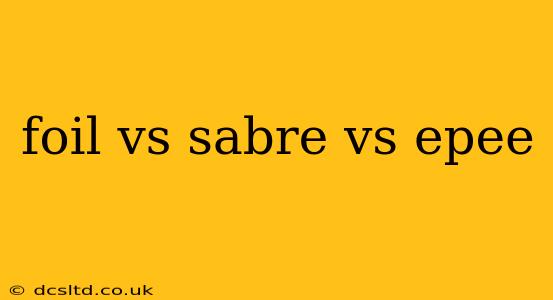Fencing, a thrilling blend of athleticism, strategy, and precision, boasts three distinct weapon types: foil, sabre, and épée. Each weapon presents unique characteristics, rules, and strategic approaches, making the sport incredibly diverse and captivating. This guide will delve into the key differences between foil, sabre, and épée, clarifying the nuances that distinguish these elegant and demanding disciplines.
What are the Differences Between Foil, Sabre, and Épée?
The primary differences between foil, sabre, and épée lie in their target area, right-of-way rules, and techniques. These distinctions shape the tactical landscape of each weapon, demanding different skill sets and strategic thinking from the fencers.
Target Area
-
Foil: The target area in foil fencing is the torso, from the shoulders to the groin, excluding the arms and legs. This relatively small target area emphasizes precision and control.
-
Sabre: Sabre fencing has the largest target area, encompassing the entire body from head to toe. This makes sabre a faster-paced and more aggressive weapon, prioritizing quick attacks and swift responses.
-
Épée: Similar to foil, the épée targets the entire body. However, unlike foil and sabre, there are no right-of-way rules in épée.
Right-of-Way
Right-of-way, a crucial element in foil and sabre, determines which fencer scores a touch when both fencers hit simultaneously.
-
Foil: In foil, the fencer who initiates the attack and lands a touch first has the right-of-way. This system encourages proactive fencing and strategic maneuvering to gain the advantage.
-
Sabre: Sabre's right-of-way is more complex. While priority is generally given to the fencer who initiates the attack, the referee must also consider the timing and effectiveness of the actions. The fast-paced nature of sabre demands quick reactions and judgment calls from the referee.
-
Épée: Épée uniquely lacks a right-of-way system. If both fencers land a touch simultaneously, both score. This emphasizes accuracy and timing since a missed touch means the opponent scores.
Fencing Techniques
The differences in target areas and right-of-way rules directly impact the favored techniques.
-
Foil: Foil fencing favors more precise, controlled thrusts, with less emphasis on cutting actions. Footwork is crucial for controlling distance and maintaining a strong defensive position.
-
Sabre: Sabre utilizes both cuts and thrusts, making it a more dynamic and aggressive weapon. Quick reflexes, explosive movements, and blade control are essential.
-
Épée: Épée fencing emphasizes both precision and power. Fencers utilize a wider range of techniques, including both thrusts and, to a lesser degree, cuts and parries, to outmaneuver opponents and score decisive touches.
Which Weapon is Right for Me?
Choosing between foil, sabre, and épée depends on your individual preferences and strengths.
-
Foil: Suitable for fencers who prefer strategic, controlled actions and a weapon that emphasizes precision and footwork.
-
Sabre: Ideal for fencers who thrive in a fast-paced, dynamic environment and enjoy aggressive, all-out attacks.
-
Épée: A great choice for those seeking a challenging weapon that rewards both precision and power, with no right-of-way to consider.
What is the difference between a foil and an epee?
The primary difference between foil and épée lies in their target area and right-of-way rules. Foil targets only the torso, and right-of-way is decided based on who initiated the attack. Épée, on the other hand, targets the entire body, and there's no right-of-way; both fencers score if they hit simultaneously.
What is the difference between a sabre and a foil?
Sabre and foil differ significantly in target area and right-of-way rules. Sabre targets the entire body and allows cuts and thrusts, with a more complex right-of-way system. Foil focuses solely on the torso using only thrusts, with a simpler right-of-way system prioritizing the attacker.
What is the most popular fencing weapon?
The popularity of fencing weapons varies by region and level of competition. However, foil is frequently cited as the most widely practiced weapon at introductory and beginner levels, due to its relative simplicity.
Conclusion
Foil, sabre, and épée each offer a unique and engaging fencing experience. Understanding their differences in target area, right-of-way rules, and techniques is crucial to appreciating the depth and diversity of this captivating sport. Whether you prefer precision and control or explosive action, there's a fencing weapon perfect for you.
